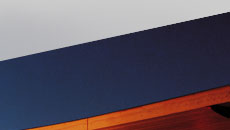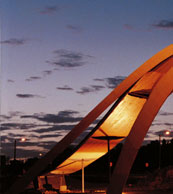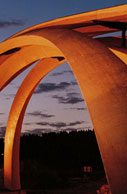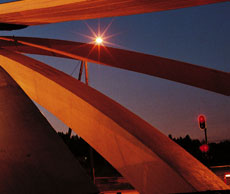Leonardo
Bridge Project
In 1502 Leonardo da Vinci did a simple
drawing of a graceful bridge with a single span of 720-foot
span (approximately 240-meters.) Da Vinci designed the
bridge as part of a civil engineering project for Sultan Bajazet
II of Constantinople (Istanbul.) The bridge was to span the
Golden Horn, an inlet at the mouth of the Bosphorus River
in what is now Turkey.
The Bridge was never built.
Leonardo's "Golden Horn" Bridge
is a perfect "pressed-bow." Leonardo surmised
correctly that the classic keystone arch could be stretched
narrow and substantially widened without losing integrity
by using a flared foothold, or pier, and the terrain to anchor
each end of the span. It was conceived 300 years prior
to its engineering principals being generally accepted. It
was to be 72 feet-wide (24 meters), 1080-foot total length
(360 meters) and 120 feet (40 meters) above the sea level
at the highest point of the span.
Norwegian painter and public art creator,
Vebjørn Sand, saw the drawing and a model of
the bridge in an exhibition on da Vinci's architectural &
engineering designs in 1996. The power of the simple design
overwhelmed him. He conceived of a project to bring its eternal
beauty to life. The Norwegian Leonardo Bridge Project
makes history as the first of Leonardo's civil engineering
designs to be constructed for public use.
Vebjørn Sand took the project to the
Norwegian Public Roads Administration. Though hardly
a visionary organization, when Sand presented the project
the reaction was unanimous. "Everyone on the project
knew we would be making something more than another boring
bridge," Sand says of his meetings with government officials,
"We would be making history."
On the Project, Vebjørn Sand successfully
collaborated with a professional team of engineers and architects
to test the build-ability of the design. Numerous sites were
considered all over Norway until the right one was found in
the township of Ås spanning E-18, the highway linking
Oslo and Stockholm. Fundraising for the project also became
a major responsibility for Sand. The next five years required
the ability to sustain the vision while building coalitions
to undertake the construction of what the Norwegian press
would call "Vebjørn Sand's Leonardo Project."
The Norwegian Leonardo Bridge Project
did not easily fall into place. Vebjørn Sand's celebrity
in Norway rests on his reputation as a young painter of considerable
ability who gleefully joined the public debate over the issue
of the dominant Modernist orthodoxy. Sand supports rigorous
technical mastery required of classical art training. The
Norwegian art academies no longer taught those skills. As
the Leonardo Bridge Project developed, this debate continued
to grow more heated in the Norwegian press. Sand's conceptual
tribute to the Renaissance thinkers, and Leonardo's vision,
came under scathing criticism. Some said the bridge belonged
in Disneyland; others accused Vebjørn Sand of being
a fascist.
Conceptually, Vebjørn Sand sees the
project as a vivid meeting between the functional and esthetical
worlds. It is a reminder that the technology the human race
has come to consider a necessary part of daily life, was possible
only by the deep faith the great geniuses of Western art and
science had in the spiritual reality of the natural world.
Nature now almost trivialized by the very pervasive-ness of
these inventions. The bridge unites the past with the present,
and expresses the greatest and the most beautiful aspect of
Renaissance art and science. That is a meeting between heaven
and earth, between the spiritual and the material realms.
To the artist, the bridge is also a beautiful
metaphor for the meeting between people, cultures and continents.
It is in itself - in its reality - the harmonic expression
of this meeting. Thus was born Vebjørn Sand's vision
to build the bridge on every continent.
# # # # # # # # # # #
Da Vinci had left sketchy instructions
in his notebooks for the construction of his design. It
has been suggested that he didn't intend for the bridge to
be anything more than a visionary sketch. But evidence of
a letter written to the Sultan, though not in Leonardo's hand,
proves that it was intended as part of a millwork project.
Since he hoped the Turkish prince would approve the project,
he is unlikely to have presented a project that couldn't be
executed.
Leonardo's design consists of a weight-bearing
granite vault with a built up walkway that forms a crossing
between terrain and vault. Granite is extremely strong under
stress and the load force of the pressed-bow design is such
that a slender and resilient span can be constructed. The
flat bridge shape, which is also seen in the viaduct over
the Golden Horn - described in the same terms as those between
pier height and arch span - give the bridge elegance and boldness.
This impression emphasizes the slim mid-portion of the bridge,
which at its narrowest point, measures only 25.5 inches (65
centimeters). Towards the sides and bottom of the arch the
construction thickness increases to 15 feet (4.5 meters) and
an anchoring footing 42 feet (14 meters) wide flairs out on
each end.
Stein Atle Haugerud, from the structural
engineering firm of Dr. techn. Olav Olsen a.s., worked
with Vebjørn Sand to construct computer renderings
of the design, testing possible durability issues. The conclusion
was that the bridge should be a pedestrian overpass to avoid
unforeseen structural problems caused by traffic vibration.
It would be a scaled-down version with a 300-feet (100 meters)
span and a total length of 400 feet (135 meters.)
Two versions of the bridge, one in stone
and one in wood, were planned. Following a tradition of bridge
construction in Norwegian culture, timber was used for the
Ås project. The bowed arches so critical to the elegant
form were created by a process of lamination developed by
the Norwegian company, Moelven Group, well known for
the 1994 Lilihammar Olympic "Viking Ship" Ice Rink.
Moelven also developed a new technique for preserving the
bright color of the Norwegian pine. An innovative walkway
material was also developed specifically for the project.
The architectural firm of Selberg Architects
created the final plans for the Project.
Through the process of development, these
world-class architects and engineers have joined Vebjørn
Sand to create a "dream team" of experts on the
history, design and structural aspects of the "Queen
of Bridges" prepared to implement the global project.
Sand's vision to build the bridge on each continent also includes
drawing on the cultural traditions, and incorporating materials,
unique to each region.
Finally, the Leonardo Bridge Project represents
a historical connection between Europe and the Middle East,
between Christianity and Islam. The Italian Renaissance was
inspired by the scholarship of the Ottoman Empire. Leonardo,
in turn, was fascinated by the Middle East. This aspect
seems particularly relevant since the events of September
11, 2001, as the Leonardo Project expands into the global
goodwill project Vebjørn Sand envisioned.
The Norwegian Leonardo Bridge was constructed
and opened to foot and bicycle traffic on October 31, 2001.
Da Vinci's vision resurrected, 500 years after the drawing
was made. Vebjørn Sand is currently considering several
sites in the United States for the next Leonardo Bridge Project.
|








